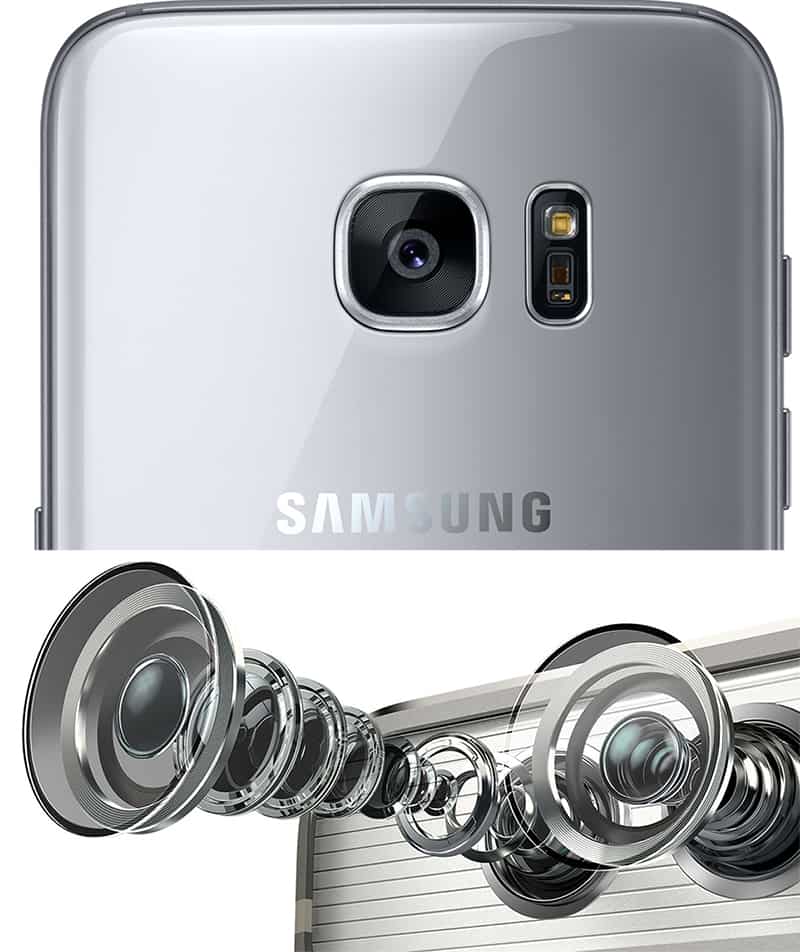
Above: Nobody pays attention to the back of a smartphone, but it’s here the next revolution in photography using these devices will come. Photos of the S7 and P9 courtesy Samsung and Huawei.
BitDepth#1040 for May 11, 2016
It was at the exact moment that I discovered that there was a market for not just a phone case with a can-opener, but a market for branded can-opener phone cases that I realised that we will never stop expecting more from the communications devices in our pockets/purses.
Eight years ago, I wrote a user focused showdown between the iPhone and the Blackberry. I’ve tended not to do them since because they become quaint and outdated all too quickly.
Back then, the discussion was all about usability, operating systems and end user experience. Things have moved on rather dramatically since then.
It’s no exaggeration to note that there are now baseline expectations for a premium mobile phone that must be met if a company’s offering isn’t going to be laughed out of the market.
A solid build, usually consisting of Gorilla Glass and sleek metal finishing, easy connectivity with a myriad of operating systems through cloud based services and acceptable size and weight for its class are now considered standard.
So this discussion isn’t really going to be about the two smartphones currently pushing the limits of what’s possible with photography using a devices that fits in your pocket, though it’s useful to compare what Samsung has been doing with it’s flagship S series with the technology Huawei brought to market with the P9.
Samsung probably hasn’t pushed to the limit of what’s possible using traditional photographic principles in a smartphone form factor with the new S7.
The company probably has more features to introduce in the S8, but it may be approaching a point of diminishing returns.
The traditional equation for good photography has consisted of a mix of the quality of the lens, the capabilities of the light gathering medium, once film, now a electronic sensor, and the magic baked into the box that brings the two together.
In the digital age, what a camera does is more programming than mechanical synchronisation. Processors examine what the sensor has gathered and decide, with varying levels of speed, how to produce a finished photo.
Programmers add to this computing process, both before capture and afterward, with a range of tweaks that respond to challenging subject matter.
For most users, the camera, when set to auto, actually knows more about your shot and how to handle it than you do.
This is no insult. Professionals working in fast moving circumstances rely on these encoded digital smarts as much as you do. It’s a feature and it’s silly not to make use of it.
The S7 sports a fast f1.7 lens and a new dual-pixel sensor that allows the device to switch focus points with impressive speed.
The Huawei P9, produced in partnership with legendary camera manufacturer Leica has delivered a smartphone with two sensors and two lenses that work in tandem to introduce some interesting new features for a mobile device.
In normal use, both cameras deliver high quality images in good light, offer complete user control over exposure with a Pro mode and the option to capture DNG RAW files.
The S7 has a bit of an edge in very low light, allowing more range in adjusting settings in manual mode.
But don’t expect magic, even with two smartphones as advanced as the S7 and P9. Both are recording images to a tiny imaging sensor, roughly half the size of the thumbnail on your little finger and there is only so much that such a small lightgathering chip can do. On both devices, ISO settings above 800 show poor detail and splotchy colour rendering in shadow areas and break up significantly at settings of 1200 or more.

Most of the time, the Huawei P9’s binocular vision and depth of field shifting works well. In this image of a fence of locks in London, it made obvious mistakes. Photo by Mark Lyndersay
The P9 has an unusual advantage with its dual sensors. One collects grayscale data only and produces unusually lush tones in B&W mode.
The camera also makes use of lightfield technology to create a generally convincing illusion of depth of field adjustment, ranging from f0.95 fo f16 through data manipulation instead of optics.
The camera gathers image data from the scene it’s pointed at with binocular vision and calculates a convincing illusion of that range of apertures from a pair of lenses set at a relatively slow f2.2.
The P9 can sometimes get that information horribly wrong and will produce the occasional Frankenstein image that’s optically impossible, but for most subjects, the results are pleasing.
Samsung is building on two decades of traditional digital camera capture with the S7 while Huawei finds itself at version one of the new wave of computational photography that’s likely to become the norm for small camera and smartphone image capture.
Much of what the P9 does that might be considered new is driven by software and that’s programming that can be improved over time if the company is so inclined.
The S7 and P9 may look similar, but it’s clear that the future of smartphone image capture is more likely to be driven by the potential of computing than it will continue to reference the principles and mechanics of photography’s past.


